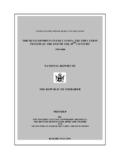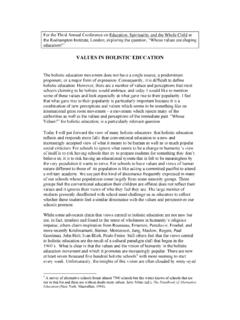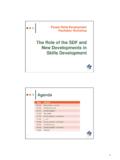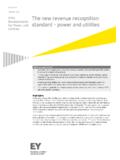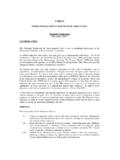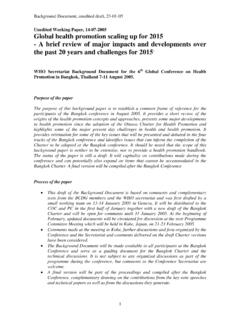Transcription of Learning Styles Again: VARKing up the right tree!
1 Learning Styles Again: VARKing up the right tree! Neil Fleming, Educational Developer and David Baume, FSEDA, Higher education Consultant Fleming, N., and Baume, D. (2006) Learning Styles Again: VARKing up the right tree!, Educational Developments, SEDA Ltd, Issue , Nov. 2006, p4-7. Introduction This article was developed in conversations (face to face and via email) between David Baume PhD FSEDA, higher education Consultant, and Neil Fleming, the designer of the VARK questionnaire and helpsheets. Understanding how we learn Students and teachers need a starting place for thinking about, and understanding, how they learn. Self-knowledge is a good start. How to get that self-knowledge? Inventories can be useful. Initially, it doesn't much matter which inventory we use. Why not? Because a Learning style is not a set of scores on some inventory, or a set of alphabetic symbols, or paragraphs of descriptors with labels. A Learning style is, rather, a description of a process, or of preferences.
2 Any inventory that encourages a learner to think about the way that he or she learns is a useful step towards understanding, and hence improving, Learning . VARK above all is designed to be a starting place for a conversation among teachers and learners about Learning . It can also be a catalyst for staff development - thinking about strategies for teaching different groups of learners can lead to more, and appropriate, variety of Learning and teaching. One proviso should be made about the VARK inventory. It is, technically, not a Learning Styles questionnaire, as it provides feedback only on one's preferred modes for communicating. These 'modal preferences for Learning ' are only a small part of what most theorists would include in a complete package deserving to be called a ' Learning style'. Some learners already know a lot about the way they learn, and need no help from any inventory or questionnaire. For others, doing the VARK questionnaire again and again over time is a worthwhile exercise, even though - maybe because - the scores may vary.
3 VARK works when people find it useful. The origins of VARK For nine years I was one of Her Majesty's school inspectors in the New Zealand education system. During this time I watched some 9000 classes. I was puzzled when I observed excellent teachers who did not reach some learners, and poor teachers who did. When I moved to Lincoln University to work in staff development , I decided to try to solve this puzzle. There are, of course, many reasons for what I observed. But one topic that seemed to hold some magic, some explanatory power, was preferred modes of Learning , 'modal preferences'. Some parts of a Learning preference are comparatively difficult for an individual to change, or for an education system to respond to - for example, preferred time of day to study, or preferred time for food intake, or motivation. But attention to preferred Learning modes allows flexibility for students and teachers to modify their behaviour, if not their preference. It seems to me that our preferences are part of who we are.
4 They inform how we approach things. We often have quite strong preferences for such things as cars, colours, food and partners. So why not look into our preferences for the ways in which we learn? The main ideas and sources that informed VARK were my prior experiences and observations, and working with students and teachers at Lincoln University who provided my laboratory and practicum. My main current ideas about preferred Learning modes include: modal preferences influence individuals' behaviours, including Learning modal preferences are not fixed, but they are stable in the medium term both students and teachers can reliably identify and provide examples of their use of modality preferences in Learning preferences can be matched with strategies for Learning . There are Learning strategies that are better aligned to some modes than others. Using your weakest preferences for Learning is not helpful; nor is using other students' preferences information that is accessed using strategies that are aligned with a student's modality preferences is more likely to be understood and be motivating the use of Learning strategies that are aligned with a modality preferences is also likely to lead to persistence Learning tasks, a deeper approach to Learning , active and effective metacognition knowledge of, and acting on, one's modal preferences is an important condition for improving one's Learning .
5 I could produce a similar list for teachers' modality preferences and their influence on students' Learning . But I am not a theorist. The development of VARK - and the name I noticed that, in response to a question such as 'How do I get ', people gave directions in different ways. I wondered if different people prefer to be told how to get there in different ways - being shown a printed map, having a map sketched for them, being told, being given written instructions, being physically taken there. So I began with a question about this. Other questions came from my work with students. I tested these questions on students whose preferences I knew from discussions and from examples of their note-taking and Learning patterns. After a couple of years I had 13 questions. I called the questionnaire VARK. It could have been KRAV or VRAK. I learned much later that VARK is Dutch for pig, and I could not get a website called because a pet shop in Pennsylvania used it for selling aardvarks - earth pigs!
6 VARK is an acronym for Visual, Aural, Read/write and Kinesthetic. VAK inventories had been around for years. What was new in my work was a second 'visual' modality for Read/write learners. From what I read and observed, it seemed obvious that some students had a distinct preference for the written word whilst others preferred symbolic information as in maps, diagrams, and charts. These two preferences were not always found in the same person. There is more acceptance of this distinction today than in the 1980s. Using VARK Users complete the questionnaire online or on paper. They can have more than one answer per question, so they get a profile of four scores - one for each modality. That begins a process of thinking about how they prefer to learn. VARK is a catalyst for metacognition, not a diagnostic or a measure. The questionnaire is deliberately kept short (13 questions -maybe 16 in the new version) in order to prevent student survey fatigue. It also tries to encourage respondents to reflect and answer from within their experience, rather than from hypothetical situations.
7 Over 180,000 people have used VARK online from mid-March to mid-September 2006. Those who answer some demographic questions make up the group called 'With Data'; the others we call 'Visitors'. There is a big jump in use after the holidays when the UK and the USA go back to school. Figures will decline slowly from the August high through to next February. Tab/e 7; Visits and Completions Visitors Visitors 2006 With Data Visitors Per Day Per Week March* 3813 13,523 781 5467 April 4823 17,178 573 4008 May 5320 20,231 653 4568 June 9850 20,509 684 4785 July 7396 15,583 503 3519 August 16,827 49,502 1597 11,178 Totals 48,029 136,526 * Only the last 17 days of March are recorded here. Tab/e 2; Regions and VARK Visitors (15th March to 11 'h September 2006) South Asia Canada Europe Oceania America UK USA 3% 2% 2% 6% 1% 9% 77% Interestingly, twice as many women as men use VARK and supply data about themselves. Also, of course, the ratio of students to teachers is high - about 6:1.
8 We know that just under 8% are completing the questionnaire for a second (or third ) time. When users get their results online, we ask if they think their results are a match to their own perceptions, or don't match or they don't know. Those figures run at 58%, 37% and 5%. I know self-perceptions don't rate highly in research, but I would be worried if those figures were in any other order. I spend a lot of time answering emails; I enjoy that, and get ideas from what others contribute. Using VARK for what? I know, from the daily stream of emails from people asking for permission to use the copyright VARK materials, that it is heavily used. (It is free for use in schools and universities.) I wish I knew more about the uses people make of it. I have a file full of examples and testimonials - and a few criticisms, too. Here are three examples of positive feedback: One teacher in the USA has been investigating the notion that maybe those students who are multimodal -that is, they prefer to use several modes to fully understand something - are missing out the most in our education systems.
9 This teacher has tracked many of the students who are asking for help at her Learning centre. A disproportionate number of these are multimodal, with scores such as 11, 10, 9, 7. Her theory is they don't get enough variety in their intake of information to confirm or settle it as new Learning . Modal impoverishment? A French professor revamped his philosophy teaching and assessment so that it allowed for 'visual' expressions of Learning , and found that a different set of students excelled Some students take their VARK scores to the teacher and say, 'Can you help me by teaching this ' I find all this fascinating. Much education is probably mono-or at the most bi-modal. Teaching often reflects the teacher's preferred teaching style rather than students' preferred Learning Styles . Managed or Virtual Learning Environments may not change that as much as we hope - they sometimes implement old teaching Styles in new technology, although with a shift from speech to text (A to R!)
10 Various students are doing research on VARK; teachers have given papers on it and made conference posters. Some UK universities have placed the VARK software on their intranets, but I don't hear much from them. I run workshops on VARK and how to use it effectively, most recently in the UK and USA, and these result in a lot of enthusiasm for VARK. The helpsheets may be the most useful part of the package. There is no shortage of Learning style inventories available. What made VARK different when it was launched in 1987 was that it came with helpsheets rather than labels. Now students can get some help with the question, 'OK. I know what I am, but what do I do about it? How can I use knowledge about my Learning preferences to help me to learn?' Some reservations and cautions about VARK Learning Styles have had a bad press. It seems that they are lauded and then attacked on an almost cyclical basis. This is probably because it is very difficult to measure Learning (in part because it is difficult to define Learning in useful ways), especially if one wants to know when Learning happens or to what it can be ascribed.



